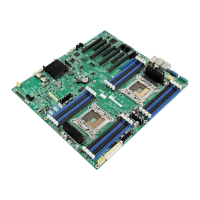Intel® Server Board S2600CO Family TPS Functional Architecture Overview
Revision 1.0 29
Intel order number G42278-002
3.2.2.5.5 Rank Sparing Mode
Rank Sparing Mode enhances the system’s RAS capability by “swapping out” failing ranks of
DIMMs. Rank Sparing is strictly channel and rank oriented. Each memory channel is a Sparing
Domain.
For Rank Sparing to be available as a RAS option, there must be 2 or more single rank or dual
rank DIMMs, or at least one quad rank DIMM installed on each memory channel.
Rank Sparing Mode is enabled/disabled in the Memory RAS and Performance Configuration
screen in the <F2> BIOS Setup Utility.
When Sparing Mode is operational, for each channel, the largest size memory rank is reserved
as a “spare” and is not used during normal operation. The impact on Effective Memory Size is to
subtract the sum of the reserved ranks from the total amount of installed memory.
Hardware registers count the number of Correctable ECC Errors for each rank of memory on
each channel during operations and compare the count against a Correctable Error Threshold.
When the correctable error count for a given rank hits the threshold value, that rank is deemed
to be “failing”, and it triggers a Sparing Fail Over (SFO) event for the channel in which that rank
resides. The data in the failing rank is copied to the Spare Rank for that channel, and the Spare
Rank replaces the failing rank in the IMC’s address translation registers.
An SFO Event is logged to the BMC SEL. The failing rank is then disabled, and any further
Correctable Errors on that now non-redundant channel will be disregarded.
The correctable error that triggered the SFO may be logged to the BMC SEL, if it was the first
one to occur in the system. That first correctable error event will be the only one logged for the
system. However, since each channel is a Sparing Domain, the correctable error counting
continues for other channels which are still in a redundant state. There can be as many SFO
Events as there are memory channels with DIMMs installed.
3.2.2.5.6 Mirrored Channel Mode
Channel Mirroring Mode gives the best memory RAS capability by maintaining two copies of the
data in main memory. If there is an Uncorrectable ECC error, the channel with the error is
disabled and the system continues with the “good” channel, but in a non-redundant
configuration.
For Mirroring mode to be available as a RAS option, the DIMM population must be identical
between each pair of memory channels that participate. Not all channel pairs need to have
memory installed, but for each pair, the configuration must match. If the configuration is not
matched up properly, the memory operating mode falls back to Independent Channel Mode.
Mirroring Mode is enabled/disabled in the Memory RAS and Performance Configuration screen
in the <F2> BIOS Setup Utility.
When Mirroring Mode is operational, each channel in a pair is “mirrored” by the other channel.
The impact on Effective Memory size is to reduce by half the total amount of installed memory
available for use. When Mirroring Mode is operational, the system treats Correctable Errors the
same way as it would in Independent channel mode. There is a correctable error threshold.
Correctable error counts accumulate by rank, and the first event is logged.

